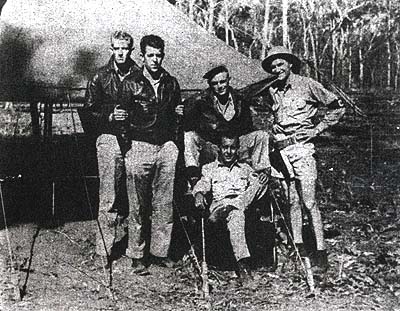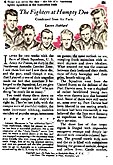Reading Room
The following is a list of books and articles about the 9FS and/or the 49FG during WWII
This list is by no means complete. Current books can be purchased from your favorite book source, online or offline. Some older books and articles are no longer in print. |
 Recently Published Books
Recently Published Books
 GEORGE
PREDDY Top Mustang Ace
GEORGE
PREDDY Top Mustang Ace
The complete combat biography
of a 27-victory ace
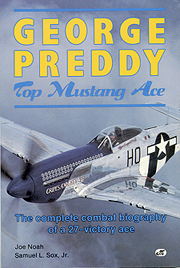
| by Joe Noah and Samuel L. Sox, Jr.
by Mindy White "This is the story of America's top Mustang Ace, Maj. George E. Preddy, hailing from Greensboro, North Carolina, Preddy was the epitome of a charming southern gentleman in addition to being a war hero. The book follows his life from pre-war barnstorming days in North Carolina, across the Pacific where he flew P-40s against the Japanese, and eventually to the Eighth Air Force where he would distinguish himself in aerial combat flying P-47s and later P-51s. With 23-83 victories while flying the P-51 Mustang, Preddy became the world's top scoring Mustang Ace. The admiration that was felt for him by his comrades is exemplified in the words of the late General John C. Meyer; "I have yet to meet a man of such single-minded and dedicated purpose, of such intense desire to excel, not for himself but for his country. George Preddy was just the greatest fighter pilot who ever squinted through a gun sight; he was the complete fighter pilot." CLICK ON FOLLOWING LINK |
 JUNGLE
ACE:
JUNGLE
ACE:
Col. Gerald R. Johnson,
the USAAF's Top Fighter Leader of the Pacific War
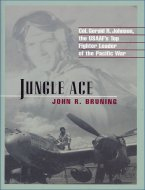
| by John R. Bruning
Following review by Ken Clark, Col. USAF (Ret) Jerry
Johnson was not your every day fighter ace of WW II, and author John
Bruning is no ordinary aviation historian. His biography of fellow
Oregonian Johnson was ten years in the making and involved exhaustive
research of official and family records and dozens of interviews with
contemporary fighter aces and squadron mates. That much is routine
scholarship. What makes Bruning
unusual is that, although not a pilot himself, he is an expert on
fighter tactics by reason of earlier employment as a designer of combat
flight simulators for Dynamix Corporation.
His descriptions of aerial combat put the reader right in the
fray, and ring true to those of us who have been there.
Available in hard cover or paperback. |
 PROTECT & AVENGE:
PROTECT & AVENGE:
The 49th Fighter Group in WWII
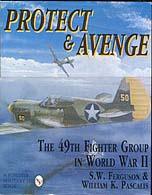
| by S.W. Ferguson and Wm. K. Pascalis
This highly acclaimed book covers the 49th Fighter Group's complete history during the war. Aviation Artist/Historian Steve Ferguson and 9FS Crew Chief/Historian William Pascalis compiled this authorized book outlining the chronological events and activities of the 49th Fighter Group: 7th Fighter Squadron, 8th Fighter Squadron, and 9th Fighter Squadron. This is a full size jacketed book with over 300 well written pages, hundreds of photos, plus handsome vintage aviation artwork. Published in 1996 by Schiffer Military/ History Publishing. Subject to availability online from several sources. |
 Tales
of a War Pilot
Tales
of a War Pilot
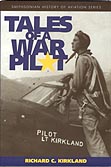
| by Richard C. Kirkland
Recently published, the author was a WWII 9FS fighter pilot in the 9FS/49FG. This jacketed book contains well written, and some humorous personal accounts of his tour of duty during the war in the Pacific, plus another section of his experiences as a helicopter pilot during the Korean War. Published in 1999 by the Smithsonian History of Aviation series, it is currently available from Amazon books. He says he has another book in the making which will be available later in 2001. |
 Aerothentic Publications
Aerothentic Publications
World Authorities on the US Fifth Air Force in WW2
by Michael John Claringbould
Please go to the book section at www.aerothentic.com for further details
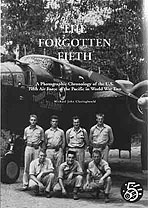
The Forgotten FifthThe Forgotten Fifth is a detail photo- graphic chronology of the Fifth Air Force from Australia to the Philippines. It con- tains among other things, rare photos, detailed histories, and an index of Fifth Air Force aircraft. |
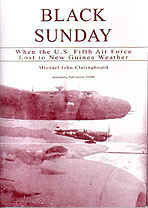
Black SundayOn 16th April 1944 the Fifth Air Force lost 37 aircraft to a weather front whilst returning from a mission against Hollandia. This book documents the entire mission, including an ac- count of every loss. Research includes Japanese, Australian and US records, six appen- dices, and rare photos.
|
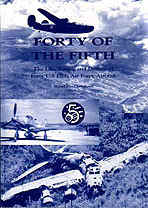
Forty of The FifthComplete with never-before published photos, this detailed work contains
the bio- graphies of forty Fifth Air Force aircraft. The book touches on MIA |
 Past Published Books
Past Published Books
 49th Fighter Group
49th Fighter Group
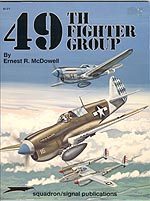
| by Ernest R. McDowell and illustrator Don Greer A very nice paperback book, it was published in 1989 by Squadron/Signal Publications. A history of the 49th Fighter Group, many B&W photos, plus many fantastic aviation art & noseart of pilots' warbirds. It is no longer in print. (On the cover, center: 7FS Capt. Nathaniel Blanton's P-40, with diamond checkered rudder; below, 9FS Lt. Ken Clark's #98 P-38 "Gypsy".) |
 Dick
Bong Ace of Aces
Dick
Bong Ace of Aces
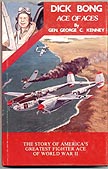
| by General George C. Kenney
Published 1980 by Zenger Publishing. This is a biography of America's ace Richard Ira Bong, who's top aerial victory credits totaled 40 during the Pacific Campaign against Japan in WWII. Major Bong was awarded the Congressional Medal of Honor by General Douglas MacArthur at Tacloban, Leyte, in 1944. (this is a revised edition of the 1960 publication.) |
 The Flying Buccaneers
The Flying Buccaneers
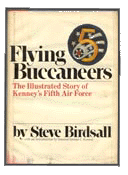
| The Illustrated Story of Kenney's Fifth Air Force by Steve Birdsall with an Introduction by General George C. Kenney Published in 1977, the book covers the complete history of the 5th Air Force during WWII. True history, plus some anecdotes as well. |
 Fighter Pilot
Fighter Pilot
| by Ralph H. Wandrey In 1950, Ace Capt. Ralph H. Wandrey published "Fighter Pilot". This book covered his 21-month tour of duty as a fighter pilot with the 9th Fighter Squadron, beginning in January, 1943. |
 49thFG, History of the Fighting 49ers
49thFG, History of the Fighting 49ers
| I can't recall the author's name. It must be out of print. |
Magazine Articles
NOTE: Copies of these articles may be obtained from
your local library reference section by request.
 'Bing Bang' Bong and the Humpty Doos
'Bing Bang' Bong and the Humpty Doos
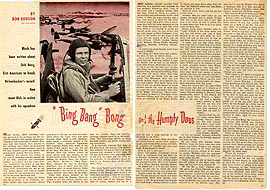
| by Bob Eunson, War Correspondent In the early 1940's, a nationally known magazine (name?) featured an article about the 9th Fighter Squadron, referring to their early Darwin era nickname "Humpty Doos", featuring (then Capt.) Major Richard I. Bong and other 9FS aces. It primarily focused on Bong becoming the first American to break Capt. Eddie Rickenbacker's record of aerial victories. |
 The Fighters at Humpty Doo
The Fighters at Humpty Doo
| by Lucien Hubbard
The famous Hollywood producer/author was a temporary publicity correspondent accredited by the USAAF, who wrote the article published by "Air Facts: The Magazine for Pilots, November, '42" to boost our morale. He lived with and wrote about the young pilots of the 9th Pursuit Squadron under the RAAF command in the Australian bush-cattle station area called Humpty Doo, south of Darwin. He referred to that campsite location due to censorship. With some minor embellishments, the story is basically true. It is here where the 9th's legendary nickname "Fighters of Humpty Doo" began. (Note: In December 1942, this article was a featured story available to the general public in condensed form by Reader's Digest.)
|
 Fowl in the Cockpit!
Fowl in the Cockpit!
| by John R. Bruning This article refers to Ralph Wandrey's wild experience during aerial combat with the 9FS's beloved mascot, Huckleberry Duck. "Fowl in the Cockpit" was published in April 1999, by FlyPast magazine, England. |
SPECIAL BOOK SECTION!!!
 The Flying Knights
The Flying Knights
Photo History of the 9th Fighter Squadron
| This book was privately published by and for the 9FS during the war. |
Visit it here...
 Memory Books
Memory Books
 Saga of the 49th FC Squadron
Saga of the 49th FC Squadron
| by Virgil "Chief" Holcomb
Printed in 1987, Virgil Holcomb writes: "Introduction The story of the US Air Corps men of the 49th Fighter Control Squadron who performed in WWII in the Southwest Pacific has not been adequately told. This book is written in an attempt to bring back the memories and the drama of the greatest mission of the 49th Fighter Control Squadron. The top flying aces in the Pacific Theater were a part of the great air battles because the Fighter Control Center sounded the alerts and scrambled the airplanes. When one reads the accounts herein, he can share the tension and excitement which took place during an air raid in the plotting room and at the controller's console. The 49th Fighter Control Squadron began to operate in a combat area and assisted pilots in the Darwin, Australia area in February 1942. Darwin was the farthermost outpost in northern Australia and was vulnerable to Japanese attack by sea and air. The 7th, 8th, and 9th Fighter Squadrons of the 49th Fighter Group were the first units to take an active part in the beginning of the war in the battle for Australia. With assistance of Australian spotter stations, radar, and the ingenuity of the 49th Fighter Control personnel, the pilots were successful in turning away the Japanese Air Force and won air supremacy over the northern part of Australia. The 49th Fighter Control Squadron was a part of the 49th Fighter Group until September 1943. The Squadron was designated as a separate unit and operated under the Fifth Fighter Command in the Pacific Theater until the end of the war. The Fighter Controllers controlled fighter and bomber aircraft during their missions and gave instructions during enemy attack. They directed fighter cover for the support of ground troops and the pilots on recco missions." Coincidentally having the same last name as the author, Ralph Holcomb (also of the 49th Fighter Control Squadron/ Cryptographer) loaned his copy of the binder-style memory book to me. It contains many references to the 7th, 8th, & 9th Fighter Squadrons and 49th Fighter Group. |
 Scrub
Team at Tacloban
Scrub
Team at Tacloban
| by Lucien Hubbard
Liberty Magazine published this article in January 1945 which referred to one particular operation during the Leyte invasion on Calaisan Peninsula. A condensed version was published by Reader's Digest in February 1945. The article omitted Virgil "Chief" Holcomb's name, although he was a key member of the team on that day. |



